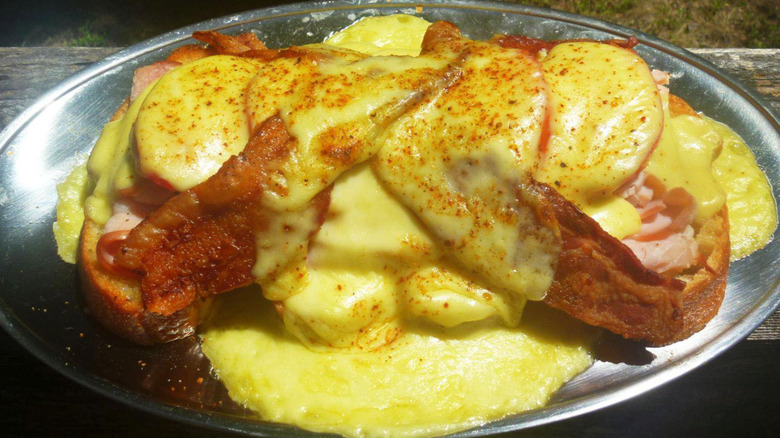The Old-School Turkey Diner Meal That's No Longer Popular
In contrast to the biggest current food trends, many dishes have fallen out of favor. As a result, items get erased from restaurant menus, recipes stop circulating in print, and flavors turn into long distant memories. There is a sense of sadness when classic dishes dip in popularity, so it's a good idea to keep tabs on fading old-school meals, such as turkey Devonshire — a creation worth remembering.
Hailing from Pittsburgh, Pennsylvania, the food's essentially an all-out open-faced sandwich. It starts with a piece of white toast — an unassuming vessel — that then holds a generously sized roasted turkey breast, followed by crisped bacon. The whole thing gets drowned in a very cheesy cheddar roux and sprinkled with parmesan and paprika. Heated in an oven right before serving, the dish comes out hot, bubbling, and huge. Upon first impression, there's an immediate visual appeal akin to a batch of Tex-Mex enchiladas or Portugal's Francesinha.
For several decades in the mid-20th century, the dish created quite a buzz around Pittsburgh. Chefs crafted unique renditions, integrating additions like tomatoes or asparagus, as well as swapping the toast for brioche and cheddar for Béchamel. Some even elevated the concept with seafood like crab meat. Unfortunately, most of the famed spots shuttered their doors, limiting Turkey Devonshire to a very select few Pennsylvania restaurants.
Turkey Devonshire declined by way of changing dining patterns
Although a clever way of upgrading turkey, it wasn't turkey Devonshire's flavor or texture that led to its downturn. Instead, the dish arrived at an opportune moment in Pittsburgh's culinary history, evolved for decades, and then the ensuing closure of iconic restaurants intertwined with the open-faced sandwich, landed it into obscurity.
It all started at the hands of Sicilian-American chef Frank Blandi, who wanted to craft a posh sandwich featuring roast turkey — a delicacy at the time. To emphasize the dish's upscale concept, he named it after nearby ritzy Devonshire Street. No one knows precisely how the assortment of ingredients came together, but by the late 1930s, the sandwich appeared on his restaurant menu.
Citywide intrigue really only picked up in the 1950s, with casual and upscale takes proliferating around the city. Some served the dish in cast iron, others used processed turkey, pushing the open-faced sandwich into varying new realms. What united the turkey Devonshire was its mode of enjoyment: It was relished as a nice lunch out. In line with its snazzy origins, most ate the dish as a large midday meal at local fine dining restaurants. Subsequently, some theorize that it's the erasure of such daytime upscale dining culture that resulted in the downfall of the turkey Devonshire.
Subsequently, tracking down a rendition today is tough; only a handful of versions remain. Instead, it's best to keep the dish alive by making it at home. Use techniques on how to store and reheat turkey, and the food makes for a great candidate to use up Thanksgiving leftovers.


